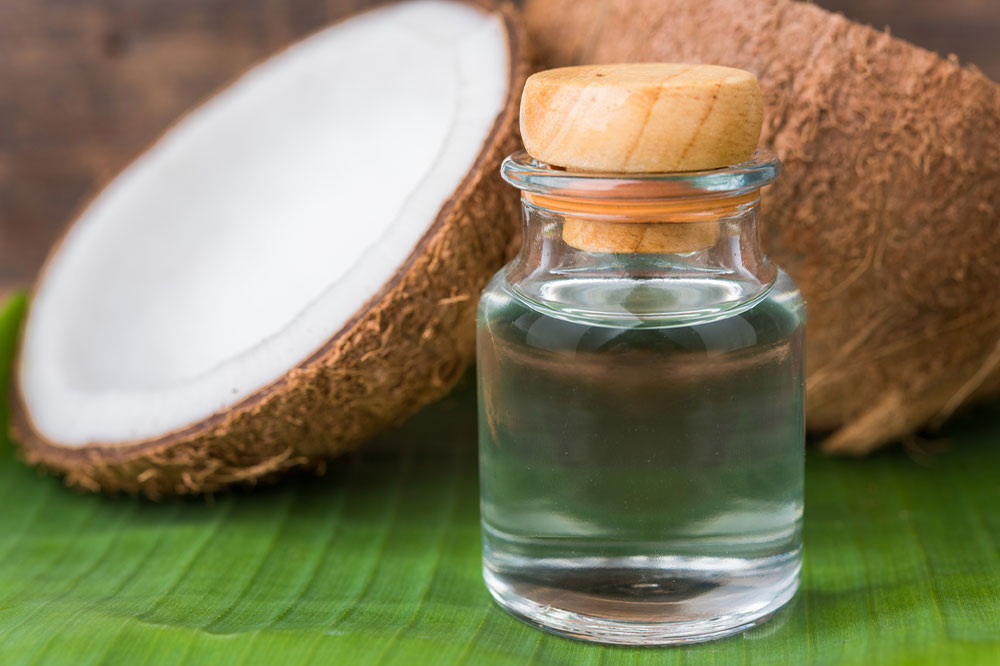9 Effective Home Remedies to Fight Atopic Dermatitis

Atopic Dermatitis, also known as Eczema, is one of the most commonly diagnosed skin disorders among children and adults of all ages. The term signifies various skin problems rather than a single condition. Approximately 31.6 million people in the country suffer from some form of atopic dermatitis. It cannot be completely cured, but one can manage flare-ups and common symptoms with prescriptions, daily nutrition, and effective home remedies, some of which are mentioned below.
Coconut oil massage
Coconut oil has the natural ability to soften and smoothen the skin from its first application. Using the oil regularly also helps keeps the skin hydrated and moisturized to combat the dryness and scaly symptoms that develop with atopic dermatitis. Most mild to moderate surface discomforts can be managed by using virgin coconut oil, as it is unrefined and boasts beneficial fatty acids that help counter inflammation.
Preparing a bleach bath
Bleach may sound like a dangerous ingredient to apply on the skin, but only in its diluted form. Surprisingly, bleach is one of the most potent compounds loaded with antibacterial and anti-inflammatory properties that effectively counter inflammation and prevent infections triggered by dermatitis. Eczema bleach baths help reduce itchiness and scaling and are very effective when combined with other remedies. Dilute some bleach in a bathtub filled with warm water and submerge yourself up to the neck in the solution. Ten minutes should be sufficient for a single session, after which therapists advise immediately drying out and applying a quality moisturizer after the bath.
Using a cool compress
Applying a cool gentle compress is one of the simplest topical home remedies that can be carried out with the least effort. Dermatologists recommend using a clean towel or new washcloth and soaking it in cold water to absorb the liquid. Wring out any excess left in the fabric and gently dab the cold compress all over the dermatitis-affected areas to soothe the inflamed and itchy spots. Do this a few times, and then finish with a generous dab of moisturizer, so the skin doesn’t dry out.
Aloe Vera for topical relief
Aloe Vera gels are one of the most powerful anti-inflammatory, antibacterial, and antifungal compounds that help alleviate the symptoms of atopic dermatitis. Widely used as a topical remedy, Aloe Vera gel naturally helps soothe, prevent flare-ups, and protect the skin by creating an active barrier. Aloe Vera also helps speed up the healing process allowing exposed wounds to heal faster with ongoing treatments topically. Using the gel extracted directly from the aloe plants or buying readymade topical gels from the pharmacy is okay. However, one should consult the dermatologist to understand the risk of increased skin sensitivity and test with a small path.
Colloidal oatmeal lotion and baths
Colloidal oatmeal is an excellent topical remedy that helps soothe the skin and counter inflammation. It is available in a fine ground-up powder form or can be made coarsely by blitzing some oatmeal at home. Even commercially available colloidal oatmeal creams can be used after consulting a dermatologist. Colloidal oatmeal provides topical relief from common symptoms like skin dryness, scaly patches, roughness, and persistent itching. The powder can also create warm oatmeal baths where the skin can absorb the antibacterial and anti-inflammatory compounds more effectively.
Fish oil
Inflammation is one of the most significant discomforts associated with atopic dermatitis. It is the body’s natural defense immune response, but chronic inflammation is painful and should not be ignored. Studies show that fish oil is rich in omega-3 fatty acids. These super potent compounds actively fight inflammation and soothe the skin for long-term relief while building resistance in the skin cells. The remedy is more effective when combined with other suggested treatments for the skin condition. Also, nutritionists advise including omega-3 fatty acids-rich seafood options in daily nutrition to supplement requirements. Tuna, salmon, herring, mackerel, anchovies, and sardines are excellent sources of natural omega-3s.
Stress relief for managing symptoms
Stress is one of the number one triggers of eczema flare-ups. Stress elevates cortisol levels in the body, affecting the function of healthy cells. This leads to the worsening of symptoms and discomforts if left unchecked for prolonged periods. Specialists suggest incorporating simple but effective stress-relieving techniques and therapies to reduce cortisol levels and prevent inflammatory reactions. Deep breathing, meditation, yoga, tai chi, music therapy, biofeedback therapies, and even counseling for cognitive behavioral therapy can help lower stress levels. The different techniques may or may not work depending on how severe atopic dermatitis symptoms affect daily lifestyle.
Changes in nutritional regime
Experts recommend eliminating certain allergy-trigger foods and processed foods from daily nutrition to reduce instances of flare-ups. If the body cannot absorb healthy vitamins, nutrients, and minerals from everyday foods, this can result in nutritional deficiencies that compromise immunity. Also, consuming processed foods further compromises immunity and may trigger inflammatory responses. Switching to organic, naturally rich sources of antioxidants taken from fresh cruciferous vegetables, dark leafy greens, legumes, and fresh fiber-rich fruits will help in the long run.
Including probiotics and supplements
Atopic dermatitis can affect young children and even infants. Several studies indicate the benefits of including more probiotics sourced from dairy or supplements to boost healthy gut bacteria. A healthy gut balance is crucial for boosting and maintaining immunity to counter active symptoms of chronic disorders like atopic dermatitis. Preventive measures stop bacterial infections triggered due to an imbalance in gut bacteria.
It is pertinent to mention that home remedies can only help manage mild to moderate symptoms, and these remedies should not be the only course of therapy. Dermatologists will recommend prescriptions and other topical treatments to control chronic symptoms in the long run.






